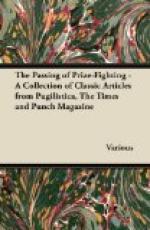An even greater sensation was caused at this juncture by a rush of cold air in the hall, followed by the appearance of a ghostly shape, which announced itself to be the shade of OZIAS HUMPHRY himself. If anyone doubted his identity or suggested that he did not paint his own pictures he should take very prompt action indeed. The art of haunting was by no means extinct. (Here the Chairman hurriedly left the room.) The shade, continuing, caused some consternation by stating that the picture which had led to litigation the other day was by no means the only supposed Romney that he had painted. He could name several in collections within a mile or two of the spot where he was then standing. (At this point Mr. HUMPHRY WARD swooned and was carried out by Mr. ROBERTS.)
Mr. A.S. TEMPLE remarked that no doubt the shade of OZIAS HUMPHRY attended that meeting in all good faith, but for his part he thought that he would have shown better taste had he kept away. In fact everyone would be happier if OZIAS HUMPHRY had never existed. It was not Art critics that should be pitched into, but painters whose styles resembled each other. They were the real nuisance. It was the duty of artists to be distinctive, and it was the duty of Art critics to keep them so. No doubt, as SHAKSPEARE knew, there was a certain humour to be extracted from men who were exactly alike, such as the two Dromios, but when painters painted alike there was no fun in it at all.
Mr. JOHN SMITH testified to the fact that he had no interest in a picture unless he knew who painted it; and even then he was not interested unless the name of the painter was a familiar one. If Art critics provided these names, it was obviously desirable that their services should be retained; but it was confusing if the Art critics disagreed among themselves. All he asked was that when they thus disagreed they should all equally fix on well-known names, even though they were different ones. Names such as REYNOLDS, GAINSBOROUGH, LEADER and GOETZE were well known and inspired confidence. Strange names merely irritated. In visiting the Royal Academy, for example, he personally always bought a catalogue and confined his attention to the pictures of the more famous artists. In this way he ensured a pleasant afternoon. If there was still any doubt as to the merit of a picture, he inquired the price and was guided by the size of that.
Sir FREDERICK WEDMORE said that to decry the value of Art criticism was absurd. It was only through the efforts of their literary henchmen that some painters could be known at all. The better the picture the more words ought to be written about it, at so much a word. It was impossible to over-estimate the importance of fitting every brush-mark with the adequate epithet. He himself had devoted a long life to this task and he intended to continue doing so. (Loud cheers.)
The Editors of the Sketch and Tatler, speaking in unison, said that not only was there too much talk about pictures, but there were far too many pictures. Artists ought not to be encouraged in the way they are. The world was never so happy as in the interval between the loss of the “Monna Lisa” and its recovery. We should apply our enthusiasm to the stage—to actors and, above all, to actresses.




